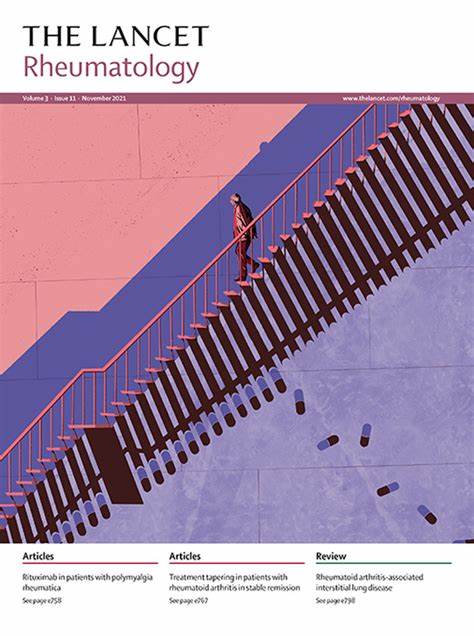Long-term effect of anifrolumab on patient-reported outcomes in systemic lupus erythematosus (TULIP-LTE): a randomised, placebo-controlled, phase 3 long-term extension trial
IF 16.4
1区 医学
Q1 RHEUMATOLOGY
引用次数: 0
Abstract
Background
In the TULIP-1 and TULIP-2 phase 3 trials, anifrolumab treatment was associated with clinical efficacy and clinically meaningful improvements in multiple patient-reported outcomes over 52 weeks in patients with moderate-to-severe systemic lupus erythematosus (SLE). At the end of TULIP-1 and TULIP-2 (week 52), eligible patients could reconsent to enter a 3-year long-term extension trial (TULIP-LTE). Here, we investigated changes in patient-reported outcomes during treatment with anifrolumab or placebo for up to 4 years in patients with SLE who were receiving standard therapy.
Methods
TULIP-LTE was a 3-year randomised, double-blind, placebo-controlled, phase 3 long-term extension of the 1-year TULIP-1 and TULIP-2 trials. Patients who were randomly assigned to receive anifrolumab 300 mg (n=257) or placebo (n=112) every 4 weeks in the TULIP-1 and TULIP-2 trials and who continued the same treatment in TULIP-LTE were assessed. Exploratory endpoints were changes from baseline in patient-reported outcomes (Short Form-36 version 2 acute recall [SF-36v2 (acute)], Patient Global Assessment of disease activity, EuroQoL 5 Dimensions-5 Levels [EQ-5D-5L], and Work Productivity and Activity Impairment-Lupus) and health utility indices, Short-Form 6-Dimension (SF-6D), derived from SF-36v2 (acute), and EQ-5D-5L. All analyses were done in the modified intention-to-treat population, which included all randomly assigned patients from TULIP-1 and TULIP-2 who received at least one dose of the same treatment during the long-term extension phase. Least-squares mean patient-reported outcome scores were adjusted using a repeated measures model. No people with lived experience were directly involved in the study design or implementation. This trial was registered with ClinicalTrials.gov, NCT02794285.
Findings
Between June 30, 2016, and Oct 12, 2018, 369 patients entered the long-term extension study and were included in this exploratory analysis (257 in the anifrolumab group and 112 in the placebo group). Mean age of patients was 42·8 years (SD 11·5), 340 (92%) of 369 patients were women and 29 (8%) were men, 250 (68%) patients were White and 82 (22%) self-identified as Hispanic or Latino. Patient-reported outcome scores improved from baseline in both groups during the 4-year treatment period. At week 208, improvement from baseline in SF-36v2 (acute) was numerically higher in the anifrolumab group than the placebo group for the bodily pain domain (least-squares mean difference 5·9 [95% CI −0·7 to 12·5]) and the mental health domain (3·7 [−1·2 to 8·6]). Improvements from baseline in SF-6D were generally greater in the anifrolumab group than the placebo group, with numerical differences between groups evident from as early as week 24 (least-squares mean difference 0·013 [−0·007 to 0·032]) and maintained at week 208 (0·016 [−0·010 to 0·042]).
Interpretation
Over 4 years of treatment, patients reported improvements in health status and health-related quality of life, including differences favouring anifrolumab compared with placebo. These numerical improvements in patient-reported outcomes occurred alongside improvements in disease activity, reduced glucocorticoid doses, and a tolerable safety profile. These data suggest that anifrolumab is an effective treatment option that might improve health-related quality of life.
Funding
AstraZeneca.
anfrolumab对系统性红斑狼疮(lip - lte)患者报告结局的长期影响:一项随机、安慰剂对照、3期长期延长试验。
背景:在TULIP-1和TULIP-2 3期试验中,anfrolumab治疗与中度至重度系统性红斑狼疮(SLE)患者52周内的临床疗效和多例患者报告的临床有意义的改善相关。在TULIP-1和TULIP-2结束时(第52周),符合条件的患者可以重新同意进入3年的长期延长试验(TULIP-LTE)。在这里,我们调查了接受标准治疗的SLE患者在接受anifrolumab或安慰剂治疗长达4年期间患者报告结果的变化。方法:TULIP-LTE是一项为期3年的随机、双盲、安慰剂对照、为期1年的TULIP-1和TULIP-2试验的3期长期延长。在TULIP-1和TULIP-2试验中,每4周随机分配接受anfrolumab 300 mg (n=257)或安慰剂(n=112)的患者,以及在TULIP-LTE中继续接受相同治疗的患者进行评估。探索性终点是患者报告的结果(Short Form-36 version 2急性回忆[SF-36v2(急性)],患者疾病活动性总体评估,EuroQoL 5维度-5水平[EQ-5D-5L],以及工作效率和活动障碍-狼疮)和健康效用指数(Short form 6维度(SF-6D),源自SF-36v2(急性)和EQ-5D-5L)的基线变化。所有的分析都是在改良的意向治疗人群中进行的,其中包括所有随机分配的TULIP-1和TULIP-2患者,他们在长期延长阶段接受了至少一剂相同的治疗。使用重复测量模型调整最小二乘平均患者报告的结果评分。没有有生活经验的人直接参与研究的设计或实施。该试验已在ClinicalTrials.gov注册,编号NCT02794285。结果:在2016年6月30日至2018年10月12日期间,369名患者进入了长期扩展研究,并被纳入了探索性分析(257名患者为anifrolumab组,112名患者为安慰剂组)。患者平均年龄为42.8岁(SD为11.5),369例患者中340例(92%)为女性,29例(8%)为男性,250例(68%)为白人,82例(22%)为西班牙裔或拉丁裔。在4年的治疗期间,两组患者报告的结果评分均较基线有所改善。在第208周,anifrolumab组的SF-36v2(急性)从基线改善的数值高于安慰剂组,在身体疼痛领域(最小二乘平均差为5.9 [95% CI - 0.7至12.5])和精神健康领域(3.7[-1·2至8.6])。anfrolumab组SF-6D较基线的改善通常大于安慰剂组,两组之间的数值差异早在第24周就很明显(最小二乘平均差为0.013[- 0.07至0.032]),并在第208周保持(0.016[- 0.010至0.042])。解释:在4年的治疗中,患者报告了健康状况和健康相关生活质量的改善,包括与安慰剂相比,anifrolumab的优势。这些患者报告结果的数值改善与疾病活动性的改善、糖皮质激素剂量的减少和可耐受的安全性的改善同时发生。这些数据表明,anifrolumab是一种有效的治疗选择,可能改善与健康相关的生活质量。资金:阿斯利康。
本文章由计算机程序翻译,如有差异,请以英文原文为准。
求助全文
约1分钟内获得全文
求助全文
来源期刊

Lancet Rheumatology
RHEUMATOLOGY-
CiteScore
34.70
自引率
3.10%
发文量
279
期刊介绍:
The Lancet Rheumatology, an independent journal, is dedicated to publishing content relevant to rheumatology specialists worldwide. It focuses on studies that advance clinical practice, challenge existing norms, and advocate for changes in health policy. The journal covers clinical research, particularly clinical trials, expert reviews, and thought-provoking commentary on the diagnosis, classification, management, and prevention of rheumatic diseases, including arthritis, musculoskeletal disorders, connective tissue diseases, and immune system disorders. Additionally, it publishes high-quality translational studies supported by robust clinical data, prioritizing those that identify potential new therapeutic targets, advance precision medicine efforts, or directly contribute to future clinical trials.
With its strong clinical orientation, The Lancet Rheumatology serves as an independent voice for the rheumatology community, advocating strongly for the enhancement of patients' lives affected by rheumatic diseases worldwide.
 求助内容:
求助内容: 应助结果提醒方式:
应助结果提醒方式:


